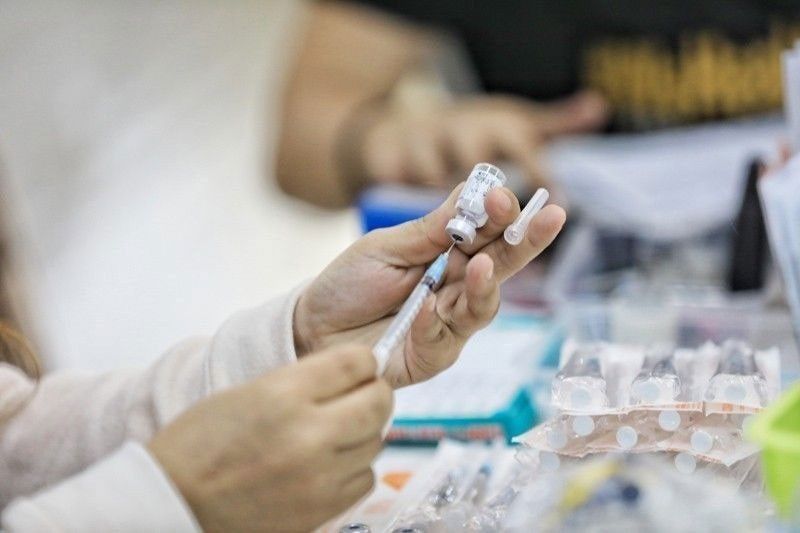400,000 bivalent vaccines arriving next week

MANILA, Philippines — The government is preparing for the arrival of close to 400,000 doses of donated bivalent COVID vaccines next week.
At a press briefing yesterday, Department of Health (DOH) officer-in-charge Maria Rosario Vergeire expressed hope the vaccines, around 391,000 doses, would arrive next week.
“We were able to submit the necessary papers and the donor country committed that the vaccines would arrive next week,” Vergeire said.
She said the DOH’s implementing units have been busy conducting meetings and orientation regarding priority groups that would receive the donated vaccines.
She said the declaration of the World Health Organization that COVID is no longer a global health emergency does not affect the bivalent vaccine donation.
Earlier, the DOH said the government of the donor country and the vaccine manufacturer agreed to drop the immunity clause.
“The clause has been modified that is why we were able to proceed (with the transaction).”
She said the country has resumed the negotiation with the COVAX Facility regarding its donation of around two million doses of bivalent vaccines.
“We informed the COVAX Facility that we are interested to receive these two million doses of bivalent vaccines,” Vergeire said.
The delivery of these vaccines had been put on hold due to the lifting of the state of calamity, which allows the continued implementation of measures meant to address the pandemic.
The bivalent jabs from COVAX were supposed to arrive in the country last March.
A bivalent vaccine targets both the original strain of COVID virus and the Omicron subvariants.
Meanwhile, Vergeire said it is not proper to use the COVID positivity rate alone to show the country’s current pandemic situation.
“To use the positivity rate to determine the spread of the disease, I will not contest that. But it is not only the positivity rate that should be used to tell our COVID situation,” she said at a press conference.
Vergeire said the positivity rate in an ideal setting means everybody had been tested.
“That will then be a good basis. But we have explained that right now, not all have undergone testing. The protocols have changed. We are doing risk-based testing. You expect that those getting tested are those already with symptoms. Given that, there is bias already. The other members of the population are not being covered,” she said.
Vergeire said that even the results of antigen testing are not being reported.
Those reported are results of the RT-PCR or reverse transcription-polymerase chain reaction tests.
“How can we capture the whole picture if we are only reporting RT-PCR tests?” she asked. “We know and they know that the numbers are not complete. You mislead the people and they panic.”
She said that even positivity rates provide information for disease spread and there is a need to disaggregate if these cases are severe, critical, mild or moderate.
“If you look at the cases, 96 percent are mild and moderate. There are only a few severe and critical cases,” she said.
Vergeire said there is a need to consider health care utilization to determine how the COVID picture is affecting us right now.
“As long as our health care system is preserved, those admitted at hospitals are at a manageable level, we are OK. There is no need to panic, but we still need to be vigilant,” she said.
The DOH said the daily average number of new COVID cases in the country is 1,798.
“This is a 28-percent increase in the average daily cases of COVID cases recorded last week, which was 1,400,” said Vergeire.
She said the national positivity rate is around 23.5 percent. “This meant a 20-percent increase from the previous week.”
As to deaths, the DOH said a total of 3,349 COVID deaths have been recorded in health facilities from Jan. 1 to May 14.
Of the figure, 1,425 were unvaccinated or 43 percent of the total.
COVID deaths down
Deaths due to COVID-19 fell by 85 percent in 2022 from a year ago, while heart disease remained the top cause of death, according to the Philippine Statistics Authority (PSA).
The statistics agency said registered deaths due to COVID reached 17,011 or 2.7 percent of the total deaths last year, way below the 112,772 deaths due to the virus in 2021.
COVID with virus identified or confirmed by a laboratory test was the 11th leading cause of death with 12,085 cases or 1.9 percent of the total deaths last year.
In 2021, COVID with virus identified was the third leading cause of death with 79,423 deaths or nine percent of the total figure.
Meanwhile, registered deaths due to COVID with virus not identified reached 4,926 or 0.8 percent of the total deaths last year.
It was the 23rd leading cause of death, down from rank 8th in 2021.
The National Capital Region logged the highest number of deaths due to COVID with 4,231 or 24.9 percent of the total fatalities last year.
“The top three causes of death in the country from January to December 2022 were ischaemic heart diseases, neoplasms and cerebrovascular diseases,” the PSA said.
Deaths due to ischaemic heart diseases reached 114,557 cases or 18.4 percent of the total deaths in 2022.
Neoplasms or cancer placed second and accounted for 63,377 deaths or 10.2 percent of total deaths last year.
This was followed by cerebrovascular diseases with 63,281 cases or 10.2 percent of total deaths in 2022.
A separate report released by the PSA yesterday showed the preliminary number of registered deaths reached 622,509 last year or 29.2 percent lower than the 879,429 deaths in 2021.
Among regions, Calabarzon (Cavite, Laguna, Batangas, Rizal and Quezon) had the highest number of registered deaths last year with 94,084 or 15.1 percent of the total figure.
Meanwhile, the preliminary number of births reached 1.25 million last year, down 8.2 percent from the 1.36 million in 2021.
Similar to registered deaths, Calabarzon topped the regions with the most number of registered births last year with 195,795 or 15.6 percent of the total.
Preliminary PSA data also showed registered marriages in the country rose 12.5 percent to 401,388 last year from 356,839 in 2021.
Calabarzon also recorded the highest number of registered marriages last year with 60,831 or 15.2 percent of the total. – Louella Desiderio
- Latest
- Trending





























